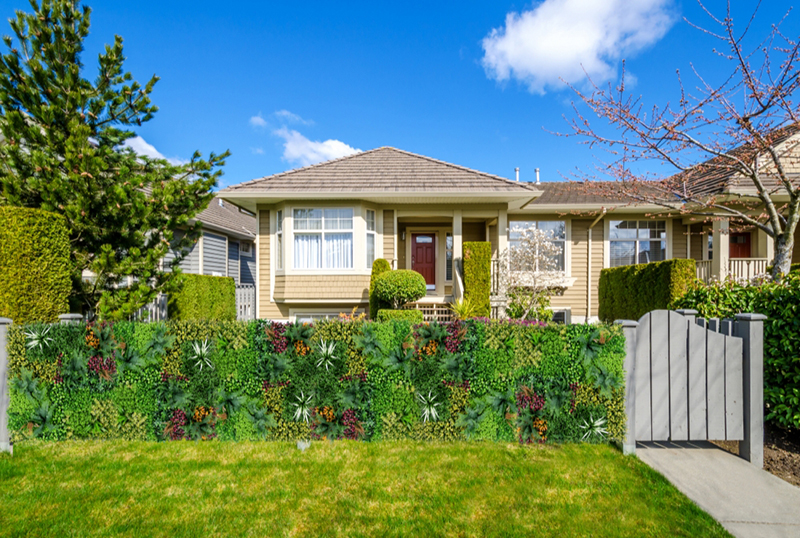Herbaceous Plant Arrangement for 3D Artificial Vertical Gardens: Designing Vibrant, Low-Maintenance Green Walls
Herbaceous plants bring softness, color, and a touch of wildness to 3D artificial vertical gardens. While artificial herbs lack the fragrance and seasonal changes of living plants, their design versatility allows for creative, year-round displays that mimic natural meadows or cottage gardens. Below are strategies for selecting and arranging artificial herbaceous plants to enhance vertical spaces.

Artificial herbaceous plants come in a range of shapes, from feathery ferns to spiky grasses. Choosing the right mix ensures visual interest and balance.
Fine-Textured Fillers: Delicate plants like artificial baby’s breath or dill add lightness and movement to dense arrangements. These work well as background layers or to soften transitions between bolder elements.
Bold, Upright Forms: Incorporate plants with sturdy stems and large leaves, such as artificial hosta or canna lilies, to create focal points. Place these in central panels or areas with recessed depths to emphasize their height.
Spiky or Grass-Like Accents: Use artificial sedges, fountain grass, or iris leaves to introduce vertical lines and contrast. These varieties break up rounded shapes and add a dynamic, architectural element.
Layering is essential for achieving a natural, three-dimensional look in vertical gardens. Artificial herbaceous plants can be positioned to mimic the way they grow in the wild.
Foreground, Midground, and Background Separation: Place shorter, more detailed plants in the foreground, medium-height varieties in the middle, and taller, bolder forms in the background. This technique creates an illusion of distance and complexity.
Overlapping Foliage: Allow some plants to “spill” over the edges of panels or overlap with neighboring species. This mimics the organic spread of real herbaceous plants and adds a sense of abundance.
Vertical Spacing for Airflow: Leave small gaps between plant clusters to prevent visual clutter and ensure the garden doesn’t appear overly dense. In artificial designs, these gaps also reduce dust accumulation and simplify cleaning.
Artificial herbaceous plants offer endless color possibilities, from soft pastels to vibrant neons. Thoughtful color pairing enhances the garden’s overall impact.
Monochromatic Schemes: Using varying shades of a single color—such as different greens or blues—creates a calming, cohesive look. This approach works well in minimalist or modern spaces where subtlety is key.
Complementary Contrasts: Pair plants with opposite colors on the wheel, like purple and yellow or red and green, to create visual excitement. These combinations draw attention to specific areas of the garden.
Gradient Transitions: Arrange plants from light to dark tones to guide the eye through the space. For example, start with pale lavender at the top and transition to deep violet at the base for a dramatic effect.
Even artificial herbaceous plants benefit from arrangements that replicate how they grow in nature. This authenticity makes the garden feel intentional rather than artificial.
Clustering by Species: Group similar plants together, as they would naturally form colonies in meadows or woodlands. For example, place several artificial coneflower varieties in a tight cluster to mimic their real-life behavior.
Asymmetrical Balance: Avoid perfectly symmetrical layouts, which can look stiff. Instead, offset larger plants with smaller ones and vary their orientations to create a more organic, flowing feel.
Incorporating “Weedy” Elements: Add a few artificial wildflowers or grasses with irregular shapes to mimic the chaos of natural environments. These details enhance the garden’s realism and prevent it from looking overly manicured.
By focusing on texture, layering, color, and natural growth patterns, artificial herbaceous plants can transform 3D vertical gardens into lively, dynamic spaces. Their durability and versatility make them ideal for a wide range of applications, from residential patios to commercial atriums, where they provide lasting beauty without the need for watering or pruning.
Contact: Amy
Phone: 86-15311787313
E-mail: info@foszmac.com
Whatsapp:86-15311787313
Add: Fengtai District, Dacheng Road, No.24 Building, Room 203, Beijing, China